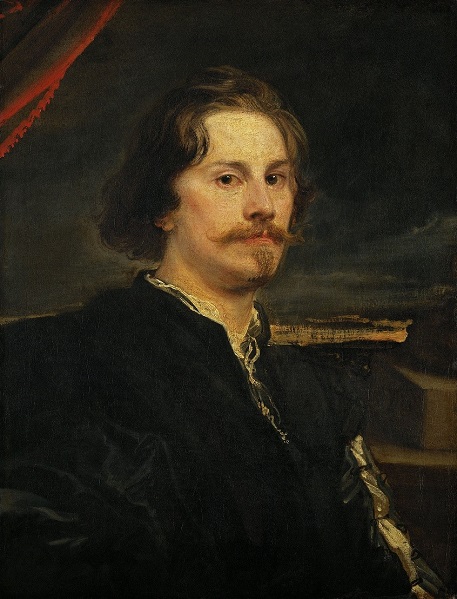The subject of Sir Anthony van Dyck’s Portrait of a Man, one of the Flemish Baroque portrait masterpieces in the Kunsthistorisches Museum in Vienna, has been identified as the Dutch Golden Age painter and engraver Pieter Soutman. After extensive research, specialists of the Jordaens and Van Dyck Panel Paintings Project (JVDPPP), a multidisciplinary art historical initiative that systematically studies the panel paintings by Jacques Jordaens and Sir Anthony Van Dyck, have discovered that the man in the portrait is in fact Van Dyck’s colleague and friend Pieter Soutman (1593/1601-1657), a competitor of Frans Hals in Haarlem, painted in Brussels in 1628. Starting 23 March, the discovery is the sole focus of the exhibition in the Kunsthistorisches Museum in Vienna, open to the public until 22 July 2018. An English version of the exhibition catalogue, in which the discovery is published, is available on the new JVDPPP website www.jordaensvandyck.org.
From the Jordaens and Van Dyck Panel Paintings Project, 21 March 2018
The Portrait of a Man has been hanging in Vienna since the last half of the 17th century. It has previously been misidentified as the Flemish painters Paul de Vos (1595-1678) and Jan Boeckhorst (1604-1668).
However, JVDPPP co-founder Justin Davies found a clue in the inventory of Archduke Leopold-Wilhelm’s collection, drawn up in 1659. It lists a portrait by Van Dyck as that ‘of the painter of the King of Poland called long Peter’. Re-examining archival documents, Davies established that this was the title used by Pieter Soutman from 1624, when he became painter to the King of Poland Sigismund III Vasa (1587-1632) and that he had been painted by Van Dyck.
Since 1949, it has been known from a 1645 letter by Pieter Soutman that there was a lost portrait. ‘The Van Dyck portrait of me is estimated as high as anyone has seen anything by Van Dyck. It will not leave my hands, even for 300 guilders in cash’, wrote Soutman, soon after Van Dyck died in London aged only 41.

Anthony Van Dyck (1599–1641), Portrait of a Man, now identified as Pieter Soutman ca. 1628
Kunsthistorisches Museum, Vienna
Sold to Archduke Leopold-Wilhelm of Austria in 1651
As young men, before they became famous, Van Dyck and Soutman worked together for the great Peter Paul Rubens in Antwerp. Ten years later, in 1628, they met again in Brussels where this portrait was likely painted. A new archival discovery by Piet Bakker, Archival Research Fellow of the JVDPPP revealed that Soutman sold his portrait to Archduke Leopold-Wilhelm (1614-1662) then ruler of the Spanish Netherlands in 1651. He brought it to Vienna in 1656.
Focus exhibition in Vienna March 2018
The painting is a rapidly executed example of Van Dyck’s brilliance. It appears almost unfinished. Single-strokes of heavy paint, impasto, are rapidly applied. A slash of white silk in the left sleeve is simply achieved by painting a jagged white line on the still visible grey preparation layer. The portrait is also known through a more finished version in Musée du Louvre. The Vienna portrait of Pieter Soutman is the subject of a focus exhibition at the Kunsthistorisches Museum in Vienna from 23 March to 22 July 2018
“Identifying it as the painter Pieter Soutman by his young friend Van Dyck brings a brilliant portrait even more to life” said Justin Davies, Co-founder, coordination and research fellow of the JVDPPP. The project’s by-line is ‘Revealing Van Dyck and Jordaens – It’s never too late for new discoveries’.
“It’s an exciting moment” said Project Leader, Dr. Joost vander Auwera, “and it’s at the heart of the project. Forensic examination of archives and scientific study of paintings to make new art historical discoveries. Sherlock Holmes meeting Silent Witness.”
Newly launched JordaensVandyck.org
Coinciding with the publication of the catalogue of the Vienna exhibition on the JVDPPP website, the JVDPPP launched its new open access website www.jordaensvandyck.org. Archival research on the key moments of the lives of both painters related to the panel paintings they made is being continually added to the website. It also includes the most comprehensive collection of documents on the Antwerp panel makers’ and Guild brand marks found by the project on the reverse of the panels. Many of these valuable seventeenth-century documents are transcribed and translated into English for the first time.
To further the global research on Flemish panel makers the website is also publishing unique translations of out of copyright articles on Van Dyck and Jordaens originally published in German, French and Dutch for the scholarly and wider community.
The JVDPPP has examined over 150 panels related to either Anthony van Dyck or Jacques Jordaens in public and private collections worldwide so far, from Puerto Rico to Budapest. All of these can be consulted on the website. Some are published for the first time. With over 250 panels to go, new paintings will be added on a regular basis.
